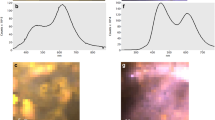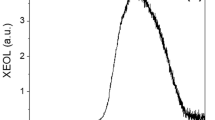Abstract
NATURAL plagioclase from terrestrial sources exhibits a cathodal luminescence spectrum which consists in general of three emission bands1,2. The emission band in the blue region of the spectrum is thought to be associated with lattice defects2, but the other emission bands are caused by transition-metal impurities present in concentrations of the order of 100–1,000 p.p.m. In particular, the emission band centred at 560 nm has been ascribed to Mn2+ ions substituting in Ca2+ sites, and the emission band on the edge of the infrared has been shown to be caused by Fe3+ ions probably in tetrahedral Al3+ sites3. The relative intensities of these emission bands vary from sample to sample, but the Fe3+ emission is often dominant in natural terrestrial plagioclases. These conclusions, concerning the nature of the luminescence centres involved, were arrived at by studying the emission characteristics of selectively activated, high purity, synthetic plagioclases3. Optical measurements presented there show that, using excitation spectroscopy, the detection of Fe3+ is possible in the plagioclase fraction of lunar fines.
This is a preview of subscription content, access via your institution
Access options
Subscribe to this journal
Receive 51 print issues and online access
$199.00 per year
only $3.90 per issue
Buy this article
- Purchase on Springer Link
- Instant access to full article PDF
Prices may be subject to local taxes which are calculated during checkout
Similar content being viewed by others
References
Geake, J. E., Walker, G., Mills, A. A., and Garlick, G. F. J., Proc. second Lunar Science Conf., Geochim. cosmochim. Acta Suppl. 2, 3, 2265–75, (1971).
Sippel, R. F., and Spencer, B., Proc. Apollo 11 Lunar Science Conf., Geochim. cosmochim. Acta Suppl. 1, 3, 2413–26 (1970).
Geake, J. E., Walker, G., Telfer, D. J., Mills, A. A., and Garlick, G. F. J., Proc. fourth Lunar Science Conf., Geochim. cosmochim. Acta Suppl. 4, 3, 3181–9 (1973).
Niebuhr, H. H., Zeira, S., and Hafner, S. S., Proc. fourth Lunar Science Conf., Geochim. cosmochim. Acta Suppl. 4, 1, 971–82 (1973).
Weeks, R. A., Proc. third Lunar Science Conf., Geochim. cosmochim. Acta Suppl. 3, 3, 2503–17 (1972).
Pott, G. T., and McNicol, B. D., J. chem. Phys., 56, 5246–54 (1972).
Faye, G. H., Can. Mineralogist, 10, 112 (1969).
Geake, J. E., and Walker, G., Infra-red and Roman Spectroscopy of Lunar and Terrestrial Minerals (edit. by Karr, C.), ch. 3 (Academic, London 1975).
Emmons, R. C., Mem. geol. Soc. Am., 52, 1 (1953).
Author information
Authors and Affiliations
Rights and permissions
About this article
Cite this article
TELFER, D., WALKER, G. Optical detection of Fe3+ in lunar plagioclase. Nature 258, 694–695 (1975). https://doi.org/10.1038/258694a0
Received:
Accepted:
Issue Date:
DOI: https://doi.org/10.1038/258694a0
This article is cited by
-
Impact-driven disproportionation origin of nanophase iron particles in Chang’e-5 lunar soil sample
Nature Astronomy (2022)
-
Site-selective mapping of metastable states using electron-beam induced luminescence microscopy
Scientific Reports (2020)
-
Luminescence excitation spectra of Mn2+ in synthetic forsterite
Physics and Chemistry of Minerals (1985)
Comments
By submitting a comment you agree to abide by our Terms and Community Guidelines. If you find something abusive or that does not comply with our terms or guidelines please flag it as inappropriate.



